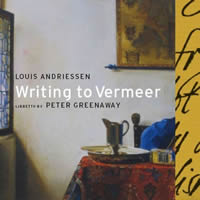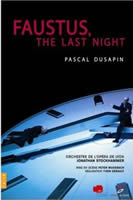Armchair Operas 1.
|
Grant Chu Covell [October 2007.]
Rued LANGGAARD: Antikrist (1921-23, 1926-30). Cast includes: Sten Byriel, Anne Margrethe Dahl, Helene Gjerris, Poul Elming, Susanne Resmark, Camilla Nylund, Jon Ketilsson, Johnny van Hal, John Lundgren. Danish National Symphony Orchestra and Choir / DR, Thomas Dausgaard (cond.). Dacapo 6.220523-24, SACD format, 2CDs; Dacapo 2.110402 DVD format (http://www.dacapo-records.dk/). Distributed in the US by Naxos (http://www.naxos.com/). Dacapo describes Langgaard’s bizarre Antikrist as a “religious mystery opera,” “magnificent doomsday vision” and “full length nightmare.” Isolated, distrustful and a chronic reviser, Langgaard stands secure as one of music’s great oddballs. Never staged during his lifetime despite frequently truculent effort, Antikrist’s composer constructed his own libretto, fashioning six tableaux to illustrate the Antichrist’s damaging effects on Earth. Most characters appear once, usually declaiming alone. The more colorful figures include Lucifer, The Mouth Speaking Great Things, Despondency, The Great Whore and The Lie. Wrapped in an opening prelude plus prologue and a concluding finale, Antikrist’s two acts contain the six scenes, each with their own prelude. It’s an extraordinary score, plundering a wide range of styles and emotions, alternately Romantic, polytonal or expressionist, sometimes concurrently. “Lust,” Scene 4, “representing the ‘Darwinistically sensual mood of power,’” could be by Strauss. Scene 1, “The Light of the Wilderness,” introduces beautifully lush Wagnerian motifs, and the following Prelude to Scene 2 emulates Hindemith’s crisp counterpoint. Indeed, the orchestral preludes teem with boisterous music, e.g., the voluminous cascades introducing Scene 5. However incongruent, the work never feels like a patchwork. Dausgaard and the Danish National Symphony Orchestra play resplendently and passionately. The opera wasn’t premiered on Danish soil until 2002 (Innsbruck mounted the premiere). With stark visuals crystallizing the experience, Dacapo’s DVD captures that Scandinavian effort. Except for the open orchestra pit, Copenhagen’s curtainless Ridehuset erases demarcation between stage and audience. The prelude reveals a dozen black-clad congregants gathering. Several will step out for their monologues. The mood is severe. Close camerawork (most likely a composite of several performances) captures expressions and details. Scene changes occur during the preludes, and staging, lights and gestures enhance the mercurial music. The allegory grows weighty. Subtitles in English (the work is sung in Danish) serve to accentuate the libretto’s Symbolist incoherence. Of course, The Great Whore would have the best costume. Bonus DVD material includes a documentary on Antikrist’s gestation and a rare black-and-white silent with glimpses of the composer conducting. Unfortunately, no recordings exist of Langgaard as a reportedly gifted organ improviser.
David SCHIFF: Gimpel the Fool (1975-79, rev. ’85). Cast includes: Richard Zeller, D’Anna Fortunato, Kevin Walsh, Thomas Glenn, Alissa Mercurio Rowe, Megan Besley, Vale Rideout, Tyler T. Oliphant, Bryan Hunt, Judith Schiff. Third Angle Ensemble, Kenneth Kiesler (cond.). Naxos 8.669010-11, 2CDs (http://www.naxos.com/). Based on an I.B. Singer story and sung in English, Schiff’s lively two acts (52:55 + 46:06) tell of Gimpel the sad-sack, the butt of cruel pranks. Tricked into marrying the town prostitute (and he must pay the dowry!), he believes the six children she bears are his. The cuckold finally learns the truth at his wife’s deathbed. Rather than taking revenge, he wanders the land telling tales. A one-time student of Elliott Carter, Schiff’s lucid chamber-orchestra scoring includes saxophone, keyboards, mandolin and accordion. Yiddish themes predominate among sly Stravinskyesque touches, with the “klezmer” tune from Mahler’s First putting in a cameo appearance. Reinforcing a rustic vocabulary, the prominent tuba part suggests Revueltas. This is a fine production, clearly sung and narrated. Naxos’ routine omission of libretto poses no obstacle.
Louis ANDRIESSEN: Writing to Vermeer (1997-98). Cast includes: Susan Narucki, Susan Bickley, Barbara Hannigan. De Nederlandse Opera, Schönberg Ensemble and ASKO Ensemble, Reinbert de Leeuw (cond.). Electronic interludes by Michel van der Aa. Nonesuch 79887-2, 2CDs (http://www.nonesuch.com/). For his third Andriessen collaboration (first came M for Man, Music, Mozart in 1991, then Rosa: The Death of a Composer in 1994), Peter Greenaway provided a simple and touching libretto. Writing to Vermeer occurs during the 1672 “rampjaar,” or Disaster Year in which Vermeer’s wife, mother-in-law and model write six letters each to the absent painter chronicling household and world events, revealing their joys and fears. More fluent than the heavier-handed Rosa (Nonesuch 79559-2), Andriessen-attuned ears will take particular note of the lush score’s violins. While traditional orchestral touches sound rather odd in an Andriessen score, a cimbalom’s twang compensates. As concerned as ever with proportion, the composer structured the six scenes according to the durations of Cage’s Six Melodies, with key events occurring at the golden sections, the last three scenes mirroring the preceding three. In the booklet’s interview, the composer cites quotations from Sweelinck, Berio and Stravinsky, as well as his brother Jurriaan’s Magnificat, and yet the opera is no pastiche. De Staat, De Stijl, and De Triologie voor den leeste Tage are not far behind. This recording nicely captures the 2004 revival under the direction of Greenaway’s partner Saskia Boddeke. The singing (in English) is superb, though for the most part the lines aren’t beautiful or flattering. Van der Aa’s electronic bits slink under the orchestra at various points to represent assassinations, uprisings and floods. Their jarring effects reinforce the opera’s concurrent layers and sense of history’s march. It’s a pity Nonesuch didn’t release a DVD, given Boddeke’s distinctive style and the booklet’s teasing production shots.
Michael GORDON, David LANG and Julia WOLFE: The Carbon Copy Building (1999). Cast includes: Theo Bleckmann, Tony Boutté, Katie Geissinger, Toby Twining. John Benthal (e-guit), David Cossin (perc), Martin Goldray (keyboards), Bohdan Hilash (woodwinds). Cantaloupe Music CA21038 (http://www.cantaloupemusic.com/). Long a fan of Ben Katchor’s cartoons depicting a waning metropolis (Julius Knipl, Real Estate Photographer), I was eager to crack the binding of this attractive little book of Katchor’s texts and colorful drawings, a world filled with rumpled salesmen measuring their lives in stained coffee cups and dingy ceiling tiles. Perhaps this is the first “comic-strip opera,” its subject, a pair of office buildings housing tenants that include Geo. Atz Broken Cookie Consolidator, Solomon Gurak Bonded Coin-Bank Breaker, Citywide Katsup Bottle Refilling Service, Standard Dust & Fume Collection Company, etc. The seamless collaborative score from the Bang on a Can troupe, supporting the straightforward, sometimes awkward prosody, doesn’t mesh comfortably with the libretto’s gently mocking, surreal mood. Then again, I’m not sure what sort of music might suit Katchor — perhaps Harry Partch or a microtonal Weill. The four-square, synth-and-guitar-heavy music doesn’t quite fit. Maybe that’s the point.
Stephen HARTKE: The Greater Good or The Passion of Boule de Suif (2006). Cast includes: Caroline Worra, John David De Haan, Christine Abraham, Andrew Wentzel, Matthew Worth, Jeanine Thames, Dorothy Byrne, Jill Gardner, Elaine Alvarez, Christopher Burchett, Seth Keeton, Katherine Calcamuggio, Christian Reinert, Liam Moran. Glimmerglass Opera Orchestra, Stewart Robertson (cond.). Naxos 8.669014-15, 2CDs (http://www.naxos.com/). Hartke’s The Greater Good takes its libretto from a Maupassant short story. In 1871 Rouen, immediately after the Prussian victory, a crowded coach bound for Dieppe resents the presence of a late-boarding passenger, the prostitute Boule de Suif. As the wintertime journey drags, she shares her food with her traveling companions. Intent on fleeing German-occupied France, they are stalled at a border crossing. After several days it becomes clear that the only way the journey will continue is if Boule yields to the Kommandant. Eventually she succumbs, the carriage departs, and the ungrateful, selfish passengers disdain the humiliated woman. This premiering cast’s performance of the two-act opera (74:05 + 68:26) doesn’t translate well to audio only; the story’s many characters are difficult to identify. Further, the singers’ uneven syllabification strains comprehension of the English-language text. I wish the orchestra were crisper and more present; brief moments hint at interesting instrumental complexities. The opera revolves around food, including, most notably, a scene accompanied by pitched bowls struck by spoons. Later, during another meal, violins imitate squeaking bedsprings.
Pascal DUSAPIN: Faustus, The Last Night (2006). Cast includes: Georg Nigl, Urban Malmberg, Robert Wörle, Jaco Huijpen, Caroline Stein. Orchestre de l’Opéra de Lyon, Jonathan Stockhammer (cond.). Naïve MO 782177, DVD format (http://www.naiveclassique.com/). Distributed in the US by Naxos (http://www.naxos.com/). We’ve briefly plugged Dusapin in our appreciations of Naïve Montaigne’s riches but never hunkered down for an extended stay. Having sampled a random collection of this active French composer’s music over the past years (concertos on Naïve, solo pieces on Accord, etc.), I’m obliged to consign Dusapin to a should-like-but-can’t-quite-figure-out category. This Naïve DVD presents the Lyon Opera performing Dusapin’s sixth opera. A gigantic clock overwhelms the set. The singers scrabble around its tilted face, avoiding the irregularly moving hands. Captured like flies in a spider’s web, Faustus and Mephistopheles banter mercilessly. (We’re on Marlowe’s turf, hence “Faustus.”) During the plot’s final night, a waylaid angel singing at top soprano range removes her wings, produces a huge shopping bag containing an electric mixer and later expires: apparently unrelated actions. Two late arrivals, Sly and Togod, infiltrate the action with obscure wit and wisdom. The obtuse English text is a collage, Burroughs-style, of wide-ranging sources: the Bible, Caligula, Shakespeare, President Bush, and so on. With their excessively animated expressions, cropped heads and matching suits, Faustus and “Meph” prance around like sleep-starved Pee-Wee Hermans. The hard-working cast takes itself very seriously, a sensible demeanor for passionate arguments and agonized declamations. You would think that the bunny suits would provide comic relief, but the wraps pass unremarked. At Faustus’ last moments, we see a tormented soul doubting the worth of his pact with the devil. Dusapin’s dark score consists largely of massed blocks, shimmering here, slogging there, an evening-long Adagio relieved by infrequent jazzy bits. Amid the languid pulse float a few recurring scale patterns. Absent the voices, one senses the possibility of a symphony.
[Previous Article:
Mostly Symphonies 5.]
[Next Article:
Italian Vacation 5.]
|





